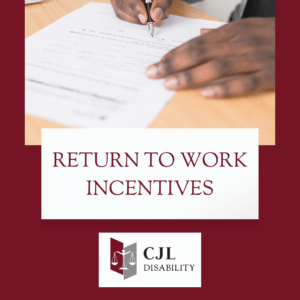Considering going back to work? Learn how SSDI return to work incentives may affect your decision.
Returning to work while receiving Social Security Disability Insurance (SSDI) or Supplemental Security Income (SSI) can feel overwhelming. Many beneficiaries worry that attempting to rejoin the workforce could jeopardize their benefits.
However, both programs offer work incentives that encourage individuals to explore employment opportunities while maintaining some or all of their benefits. Understanding these incentives is critical to maximizing your earnings without losing essential support.
What Are Work Incentives?
Work incentives are special rules designed to help SSDI and SSI recipients work and still receive monthly payments, along with Medicare or Medicaid coverage. These provisions allow individuals to test their ability to work without the immediate risk of losing their benefits, providing a safety net as they transition back into the workforce.
Social Security Disability Insurance (SSDI) Program
The SSDI program benefits individuals who are disabled or blind and are “insured” through contributions made to the Social Security trust fund via the Federal Insurance Contributions Act (FICA). These contributions are based on your work history or the work history of your spouse or parents.
The SSDI program is authorized under Title II of the Social Security Act, and in some cases, dependents may also qualify for benefits based on their earnings record.
Supplemental Security Income (SSI) Program
SSI is a need-based program that offers payments to people who are aged, blind, or disabled, including children, and have limited income and resources. SSI is funded by general tax revenue and is designed to help those who have not paid into the Social Security system or need additional financial assistance.
Key SSDI Return to Work Incentives
For SSDI recipients, several work incentives enable a gradual return to employment without the immediate loss of benefits. Understanding how these incentives work can help you make informed decisions about re-entering the workforce.
Trial Work Period (TWP)
The Trial Work Period lets you test your ability to work for up to nine months without giving up your full SSDI benefits, regardless of how much you earn. During this period, you continue to receive your SSDI payments as long as you report your work activity and your disability continues. The nine months do not have to be consecutive, and the TWP only ends once you have completed nine months of work within a rolling 60-month period.
Extended Period of Eligibility (EPE)
After completing the TWP, the 36-month Extended Period of Eligibility begins. During the EPE, you can continue to receive SSDI benefits for any month in which your earnings do not exceed the Substantial Gainful Activity (SGA) limit. If your earnings exceed the SGA threshold, you will not receive benefits for that month, but your benefits can be reinstated in any subsequent month during which your earnings fall below the SGA level.
Expedited Reinstatement (EXR)
If your benefits stop because of work, you have five years to request reinstatement without needing to file a new application if your disability prevents you from working again. This expedited reinstatement process provides temporary benefits for up to six months while your case is reviewed.
Impairment-Related Work Expenses (IRWE)
Certain out-of-pocket expenses related to your disability that are necessary for you to work, such as transportation, medical devices, or specialized work equipment, can be deducted from your earnings when determining whether you meet the SGA threshold. This allows you to earn more while maintaining your benefits.
Continuation of Medicare Coverage
If you lose your SSDI benefits due to work, you can continue to receive Medicare coverage for at least 93 months after your Trial Work Period. This ensures that your access to essential healthcare is not abruptly cut off as you re-establish yourself in the workforce.
SSI Work Incentives
SSI recipients’ work incentives differ slightly but aim to support individuals in exploring work opportunities.
Earned Income Exclusion
SSI does not count the first $65 of earned income plus half of the amount over $65 when calculating your benefit amount. This exclusion helps you keep more of your SSI payments as you work.
Student Earned Income Exclusion (SEIE)
If you are a student under age 22 and regularly attending school, the SSI program excludes a certain amount of your monthly earned income, up to a yearly limit, when calculating your benefit amount. This helps students gain work experience without losing critical benefits.
Plan to Achieve Self-Support (PASS)
PASS lets you set aside income or resources for a specific work goal, like starting a business or pursuing education, without affecting your SSI eligibility. This incentive supports long-term financial planning and career development.
Blind Work Expenses (BWE)
For individuals who are blind, the SSI program excludes expenses related to earning income, such as guide dog expenses, transportation costs, and professional equipment. These exclusions can help maintain your SSI benefits while working.
Take Advantage of SSDI Work Incentives with Skilled Guidance
Navigating SSDI and SSI work incentives can be complex, but these options offer valuable opportunities to test your ability to work while still receiving critical support. You should seek professional guidance to understand your rights and fully maximize these incentives.
Contact Culbertson, Jacobs & LaBoda Today
At Culbertson, Jacobs & LaBoda, our experienced disability attorneys are dedicated to helping you navigate the SSDI and SSI work incentives that are available to you. Whether you are returning to work for the first time or need assistance with an appeal, we are here to provide the expert guidance you need.
Contact us today to discuss your case and learn how we can help you pursue the benefits you deserve and your employment goals.

